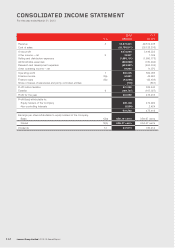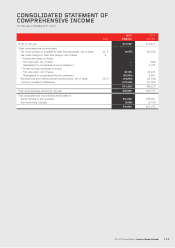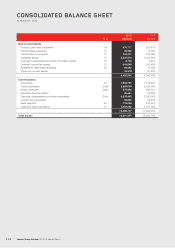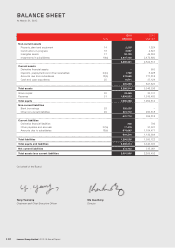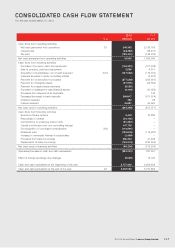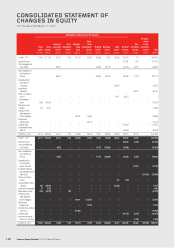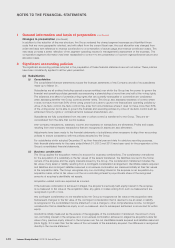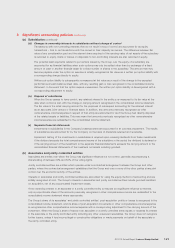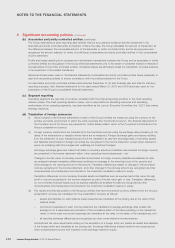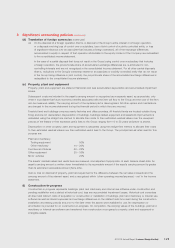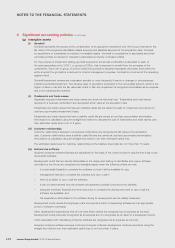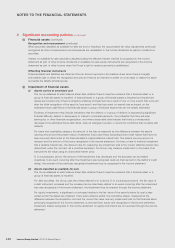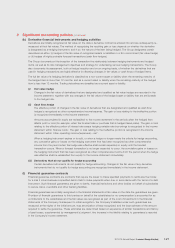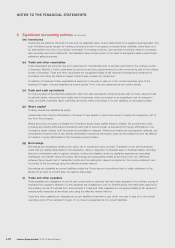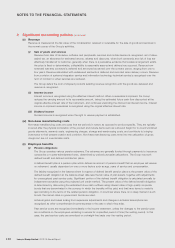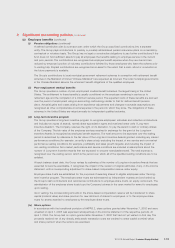Lenovo 2013 Annual Report Download - page 123
Download and view the complete annual report
Please find page 123 of the 2013 Lenovo annual report below. You can navigate through the pages in the report by either clicking on the pages listed below, or by using the keyword search tool below to find specific information within the annual report.
2012/13 Annual Report Lenovo Group Limited 121
2 Significant accounting policies (continued)
(a) Subsidiaries (continued)
(iii) Changes in ownership interests in subsidiaries without change of control
Transactions with non-controlling interests that do not result in loss of control are accounted for as equity
transactions – that is, as transactions with the owners in their capacity as owners. The difference between fair
value of any consideration paid and the relevant share acquired of the carrying value of net assets of the subsidiary
is recorded in equity. Gains or losses on disposals to non-controlling interests are also recorded in equity.
The potential cash payments related to put options issued by the Group over the equity of a subsidiary are
accounted for as financial liabilities when such options may only be settled other than by exchange of a fixed
amount of cash or another financial asset for a fixed number of shares in the subsidiary. The amount that may
become payable under the option on exercise is initially recognized at fair value as a written put option liability with
a corresponding charge directly to equity.
Written put option liability is subsequently re-measured at fair value as a result of the change in the expected
performance at each balance sheet date, with any resulting gain or loss recognized in the consolidated income
statement. In the event that the option expires unexercised, the written put option liability is derecognized with a
corresponding adjustment to equity.
(iv) Disposal of subsidiaries
When the Group ceases to have control, any retained interest in the entity is re-measured to its fair value at the
date when control is lost, with the change in carrying amount recognized in the consolidated income statement.
The fair value is the initial carrying amount for the purposes of subsequent accounting for the retained interest
as an associate, joint venture or financial asset. In addition, any amounts previously recognized as other
comprehensive income/expense in respect of that entity are accounted for as if the Group had directly disposed
of the related assets or liabilities. This may mean that amounts previously recognized as other comprehensive
income/expense are reclassified to the consolidated income statement.
(v) Separate financial statements
Investments in subsidiaries in the Company’s balance sheet are accounted for at cost less impairment. The results
of subsidiaries are accounted for by the Company on the basis of dividends received and receivable.
Impairment testing of the investments in subsidiaries is required upon receiving dividends from these investments
if the dividend exceeds the total comprehensive income of the subsidiary in the period the dividend is declared or
if the carrying amount of the investment in the separate financial statements exceeds the carrying amount in the
consolidated financial statements of the investee’s net assets including goodwill.
(b) Associates and jointly controlled entities
Associates are entities over which the Group has significant influence but not control, generally accompanying a
shareholding of between 20% and 50% of the voting rights.
Jointly controlled entities are entities which operate under a contractual arrangement between the Group and other
parties, where the contractual arrangement establishes that the Group and one or more of the other parties share joint
control over the economic activity of the entities.
Interests in associates and jointly controlled entities are accounted for using the equity method of accounting and are
initially recognized at cost. The Group’s interests in associates and jointly controlled entities include goodwill identified
on acquisition, net of any accumulated impairment losses.
If the ownership interest in an associate or a jointly controlled entity is reduced but significant influence is retained,
only a proportionate share of the amounts previously recognized in other comprehensive income are reclassified to the
consolidated income statement where appropriate.
The Group’s share of its associates’ and jointly controlled entities’ post-acquisition profits or losses is recognized in the
consolidated income statement, and its share of post-acquisition movements in other comprehensive income/expense
is recognized as other comprehensive income/expense with a corresponding adjustment to the carrying amount of the
investment. When the Group’s share of losses in an associate or a jointly controlled entity equals or exceeds its interest
in the associate or the jointly controlled entity including any other unsecured receivables, the Group does not recognize
further losses, unless it has incurred legal or constructive obligations or made payments on behalf of the associate or
the jointly controlled entity.



